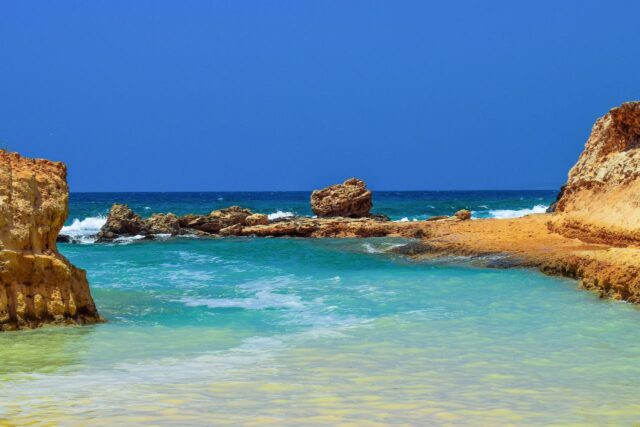The Blue Lagoon in Cyprus is one of the island’s most famous and picturesque spots. This natural bay, located on the northwest coast of the Akamas Peninsula, amazes with its clear waters, soft sandy bottom, and deep turquoise sea. From above, the lagoon appears like a vast pool surrounded by mountains and cliffs, and its calm waters are considered the clearest in Cyprus.

Contents
Geographical location and features
The Blue Lagoon is located between Cape Arnaoutis and Fontana Amorosa Bay, approximately 50 kilometers from Paphos and 7 kilometers from the village of Latsi. It is part of the Akamas National Park Protected Area, where development is strictly limited to preserve the unique ecosystem.
The lagoon’s shoreline is formed by limestone cliffs that gently slope into the water. The depth in the center reaches about 8-10 meters, but closer to the shore the sea is shallow, with an ideal entry for swimming. The sand at the bottom is light, giving the water an unusually clear blue color.
Water temperatures in summer reach up to 28°C, and transparency often exceeds 20 meters—making the Blue Lagoon a popular spot for scuba diving and snorkeling.
Historical context and natural significance
The Akamas Peninsula has been considered a sacred place since ancient times. According to myth, it was here that the goddess Aphrodite first met her lover, Adonis. The lagoon remained inaccessible for a long time and retained its pristine appearance.
Ecologically, the Blue Lagoon is an important part of Cyprus’s marine biosphere. It is home to rare fish species, sea sponges, octopuses, and starfish. Endemic plants grow in the coastal area, and nesting sites for seabirds and turtles can be found nearby.
Due to its cleanliness and lack of industrial impact, the lagoon has received the unofficial status of one of the most ecologically favorable zones in the Mediterranean region.
How to get to the Blue Lagoon
There are several ways to get to this place, and each one offers a different type of experience.
Sea trip
The most popular way to get there is by boat or yacht from Latchi Port. The journey takes about 30–40 minutes. During the cruise, you can see the Akamas coastline, bays, and cliffs, and even stop for a swim. Many boats have glass bottoms, allowing you to admire the underwater world.
Car or buggy
A dirt road leads to the Blue Lagoon, starting near the village of Neo Chorio. The route winds through hills, pine groves, and viewpoints with panoramic views. The road is suitable for 4x4s, quad bikes, and buggies, but is not suitable for cars due to the rocky surface.
Walking route
Active travelers can hike along the ecological trails from the Baths of Aphrodite area. The walk takes about two hours each way, but offers the best views of the peninsula’s bays and cliffs.
Swimming and the underwater world
The Blue Lagoon’s main feature is its amazingly clear water. Even at depth, marine plants and a sandy bottom are visible. There are virtually no currents, making swimming safe even for children.
Snorkelers and underwater photographers can see schools of colorful fish, sea urchins, coral formations, and small caves. The sea is especially calm in the morning, and the sun’s reflection creates a “liquid glass” effect.
Mooring buoys are installed in some areas, allowing boats to anchor without damaging the seabed. Swimming is permitted throughout, but diving from the rocks is not recommended, as the depth changes dramatically near the shore.

What to take with you
There are no permanent cafes, shops, or recreation areas within the Blue Lagoon, so it’s worth preparing in advance:
- take water and a light snack;
- sun protection – hat, sunscreen and glasses;
- mask and snorkel;
- comfortable shoes for the rocky shore;
- waterproof case for phone or camera.
Some boat tours offer meals and drinks on board, but if you’re traveling independently, it’s best to make arrangements in advance.
Best time to visit
The Blue Lagoon is accessible almost year-round, but the most comfortable months are from May to October. In May, the water is already warm, but there are few tourists. June and September are ideal: the sea is calm, the sun is milder than in August, and the nature retains its rich colors.
In July and August, the lagoon becomes busier with tourists and yachts, so it’s best to visit in the morning or after 4:00 pm, when the lighting makes the water especially bright.
In winter, swimming is only possible for the hardy, but a walk along the shore and the view of the clear water remain impressive.

Safety and visiting rules
The lagoon is located in a protected natural park, so the following restrictions apply:
- it is prohibited to leave litter, make fires and play loud music;
- it is forbidden to take out stones or shells;
- during sea excursions, boats are required to keep a distance from the shore and not damage corals with propellers.
Please note that there are no lifeguards on site. In windy weather, the water can be choppy, especially near the lagoon’s exit.
Viewing platforms and photography
The Blue Lagoon is one of the most photographed spots in Cyprus. The turquoise hues of the water change throughout the day, from clear aquamarine in the morning to deep sapphire in the evening.
The best vantage points are on the cliffs above the lagoon, offering panoramic views of the sea and the green hills of Akamas. This location is often chosen for wedding photo shoots, yoga retreats, and video shoots.
At sunset, the rocks take on a golden hue, and the reflection of the sun on the water creates a glowing effect—a moment that many tourists come here for in the evening hours.
Ecological value and protection
The lagoon is part of a Natura 2000 protected area, where construction and mass tourism are prohibited. Monitoring programs for the water, flora, and fauna are conducted here.
Thanks to access control and the efforts of environmentalists, the Blue Lagoon maintains its pristine beauty. It is an example of how Cyprus combines tourism and conservation, offering visitors the opportunity to enjoy its beauty without harming the ecosystem.
The Blue Lagoon is one of the most stunning places in Cyprus, where nature remains untouched and the sea is stunning in its purity and depth of color. It’s the perfect spot for swimming, strolling, snorkeling, and contemplation. Here, you’ll experience the harmony between the sea, sun, and mountains—that very natural magic that makes visiting Cyprus worth it at least once.

















